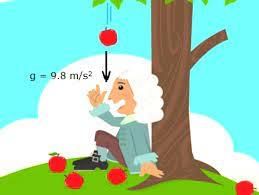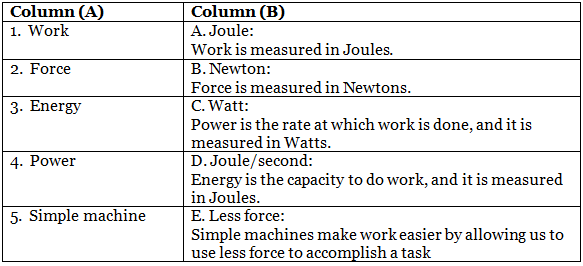Work, Force, Energy and Simple Machines - 1 Class 5 Worksheet Science
Q1: Multiple Choice Questions (MCQs).
(i) Which of the following is an example of a simple machine?
(a) Car
(b) Lever
(c) Airplane
(d) Computer
(ii) What is work?
(a) The force applied to an object
(b) The energy transferred by a force to move an object
(c) The distance an object moves
(d) The speed at which an object moves
(iii) Which of the following is a unit of force?
(a) Newton (N)
(b) Joule (J)
(c) Watt (W)
(d) Meter (m)
(iv) Which of the following is a unit of energy?
(a) Newton (N)
(b) Joule (J)
(c) Watt (W)
(d) Meter (m)
(v) What is the purpose of a simple machine?
(a) To make work harder
(b) To reduce the amount of energy needed
(c) To increase the amount of force needed
(d) To make work easier
Q2: Fill in the Blanks.
(i) Work is done when _______ is applied to an object, and it moves a certain _______.
(ii) The unit of measurement for work is _______.
(iii) _______ force is applied when we push, pull, or lift something with our hand.
(iv) Gravitational force is the force that attracts objects towards the _______.
(v) A heated substance possesses _______ energy.
Q3: True or False.
(i) Frictional force tries to stop the movement of objects across a surface.
(ii) Potential energy is the energy due to an object's position or motion.
(iii) The law of conservation of energy states that energy can be created or destroyed.
(iv) In a first-class lever, the load is between the fulcrum and the effort.
(v) A pulley used for drawing water from a well is a movable pulley.
(vi) Work is done only when an object moves.
(vii) Gravity is a force that pushes objects away from the Earth.
(viii) A lever is an example of a simple machine.
(ix) Energy can be created or destroyed.
(x) The pulley is a simple machine that helps lift heavy objects.
Q4: Match the column.

Q5: Short Answer Questions.
(i) Explain the formula for calculating work.
(ii) Give an example of each type of force mentioned in the text.
(iii) Define potential energy and kinetic energy with examples.
(iv) What are the six different types of simple machines.
(v) Explain how a pulley works.
(vi) What is the principle of conservation of energy?
Q6: Long Answer Questions.
(i) Explain the three types of levers with examples.
(ii) Describe the different forms of energy mentioned in the text and their applications in daily life.
(iii) Explain the working principle of a wheel and axle with real-life examples.
You can find Worksheets Solutions here: Worksheet Solutions: Work, Force, Energy and Simple Machines - 1
|
42 videos|230 docs|45 tests
|
FAQs on Work, Force, Energy and Simple Machines - 1 Class 5 Worksheet Science
| 1. What is work and how is it related to force and energy? |  |
| 2. What are the different types of simple machines and how do they make work easier? |  |
| 3. How does a pulley system work and what are its advantages? |  |
| 4. What is the relationship between work, force, and distance? |  |
| 5. How does an inclined plane make work easier? |  |






















